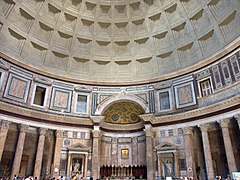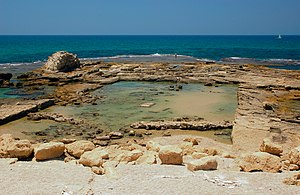
Back خرسانة رومانية Arabic Remischa Beton BAR Opus caementicium Catalan Opus caementum Czech Romersk beton Danish Opus caementicium German Opus caementicium Esperanto Opus caementicium Spanish Opus caementicium Finnish Opus caementicium French


Roman concrete, also called opus caementicium, was used in construction in ancient Rome. Like its modern equivalent, Roman concrete was based on a hydraulic-setting cement added to an aggregate.
Many buildings and structures still standing today, such as bridges, reservoirs and aqueducts, were built with this material, which attests to both its versatility and its durability. Its strength was sometimes enhanced by the incorporation of pozzolanic ash where available (particularly in the Bay of Naples). The addition of ash prevented cracks from spreading. Recent research has shown that the incorporation of mixtures of different types of lime, forming conglomerate "clasts" allowed the concrete to self-repair cracks.[1]
Roman concrete was in widespread use from about 150 BC;[2] some scholars believe it was developed a century before that.[3]
It was often used in combination with facings and other supports,[4] and interiors were further decorated by stucco, fresco paintings, or coloured marble. Further innovative developments in the material, part of the so-called concrete revolution, contributed to structurally complicated forms. The most prominent example of these is the Pantheon dome, the world's largest and oldest unreinforced concrete dome.[5]
Roman concrete differs from modern concrete in that the aggregates often included larger components; hence, it was laid rather than poured.[6] Roman concretes, like any hydraulic concrete, were usually able to set underwater, which was useful for bridges and other waterside construction.
- ^ Chandler, David L. (6 January 2023). "Riddle solved: Why was Roman concrete so durable?". MIT News. Archived from the original on 21 January 2023.
- ^ "National Pozzolan Association: The History of Natural Pozzolans". pozzolan.org. Retrieved 2021-02-21.
- ^ Boëthius, Axel; Ling, Roger; Rasmussen, Tom (1978). "Etruscan and Early Roman Architecture". Yale/Pelican history of art. Yale University Press. pp. 128–129. ISBN 978-0300052909.
- ^ "Aqua Clopedia, a picture dictionary on Roman aqueducts: Roman concrete / opus caementicium". romanaqueducts.info. Retrieved 2023-01-24.
- ^ Moore, David (February 1993). "The Riddle of Ancient Roman Concrete". S Dept. of the Interior, Bureau of Reclamation, Upper Colorado Region. Retrieved 20 May 2013.
- ^ Henig, Martin, ed. (1983). A Handbook of Roman Art. Phaidon. p. 30. ISBN 0714822140.